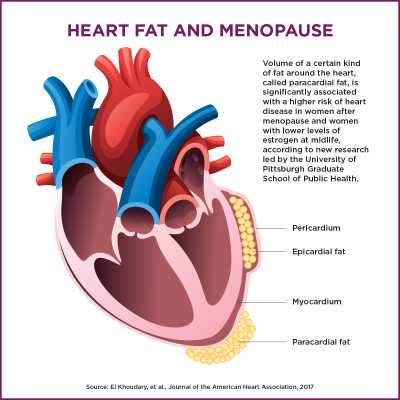23 Feb Paracardial Fat Linked To Postmenopausal Coronary Artery Calcification
MedicalResearch.com Interview with:
Samar R. El Khoudary, Ph.D., M.P.H.
Assistant professor
Department of Epidemiology
University of Pittsburgh Graduate School of Public Health
MedicalResearch.com: What is the background for this study? What are the main findings?
Response: Our study revealed a previously unknown, menopause-specific indicator of heart disease risk. For the first time, we’ve pinpointed the type of heart fat, linked it to a risk factor for heart disease and shown that menopausal status and estrogen levels are critical modifying factors of its associated risk in women.
My team evaluated clinical data, including blood samples and heart CT scans, on 478 women from Pittsburgh and Chicago enrolled in the Study of Women’s Health Across the Nation (SWAN). The women were in varying stages of menopause, averaged 51 years old and were not on hormone replacement therapy.
In a previous study, we showed that a greater volume of paracardial fat, but not epicardial fat, after menopause is associated with a decline in the sex hormone estradiol—the most potent estrogen—in women. The higher volume of epicardial fat was tied to other risk factors, such as obesity.
In the new study, we built on those findings to discover that not only is a greater paracardial fat volume specific to menopause, but—in postmenopausal women and women with lower levels of estradiol—it’s also associated with a greater risk of coronary artery calcification, an early sign of heart disease that is measured with a heart CT scan.
MedicalResearch.com: What should readers take away from your report?
Response: Epicardial and paracardial fat are distinct types of heart fat that are found to be greater in postmenopausal women as compared with premenopausal women for different reasons with different effects on heart disease risk—and thus should be evaluated separately. The menopausal transition is a critical period of women’s lives since women are subjected to several adverse changes that could increase their risk of heart disease. Women should be aware of risk factors that could be specific to this stage of their life.
MedicalResearch.com: What recommendations do you have for future research as a result of this study?
Response: Our study could not prove causality due to the cross-sectional nature of the study design. Therefore, it is important to replicate our findings by following women over time and assessing the impact of changes in heart fat on women’s risk for heart disease. A recent analysis of previous research found that heart fat volumes could be reduced successfully with dieting and bariatric surgery. Given the uncertainty about the cardio-protective effects of hormone replacement therapy, as well as the lack of research on the impact of such therapy on heart fat volumes, I am planning a study to evaluate hormone replacement therapy on heart fat accumulation, paying particular attention to the types of heart fat.
MedicalResearch.com: Is there anything else you would like to add?
Response: Additional authors on this study are senior author Karen A. Matthews, Ph.D., of Pitt; and co-authors Kelly J. Shields, Ph.D., of Allegheny Health Network; Imke Janssen, Ph.D., and Lynda H. Powell, Ph.D., both of Rush University Medical Center; Matthew Budoff, M.D., of the Los Angeles Biomedical Research Institute; and Susan A. Everson-Rose, Ph.D., of the University of Minnesota Medical School.
This research was supported by National Institutes of Health grants U01NR004061, U01AG012505, U01AG012535, U01AG012531, U01AG012539, U01AG012546, U01AG012553, U01AG012554, U01AG012495, HL065581 and HL065591; and American Heart Association grant 12CRP11900031.
MedicalResearch.com: Thank you for your contribution to the MedicalResearch.com community.
Citation: Postmenopausal Women With Greater Paracardial Fat Have More Coronary Artery Calcification Than Premenopausal Women: The Study of Women’s Health Across the Nation (SWAN) Cardiovascular Fat Ancillary Study
Samar R. El Khoudary, Kelly J. Shields, Imke Janssen, Matthew J. Budoff, Susan A. Everson‐Rose, Lynda H. Powell, Karen A. Matthews
https://doi.org/10.1161/JAHA.116.004545
Journal of the American Heart Association. 2017;6:e004545
Originally published January 29, 2017
Note: Content is Not intended as medical advice. Please consult your health care provider regarding your specific medical condition and questions.
More Medical Research Interviews on MedicalResearch.com
Last Updated on February 23, 2017 by Marie Benz MD FAAD


